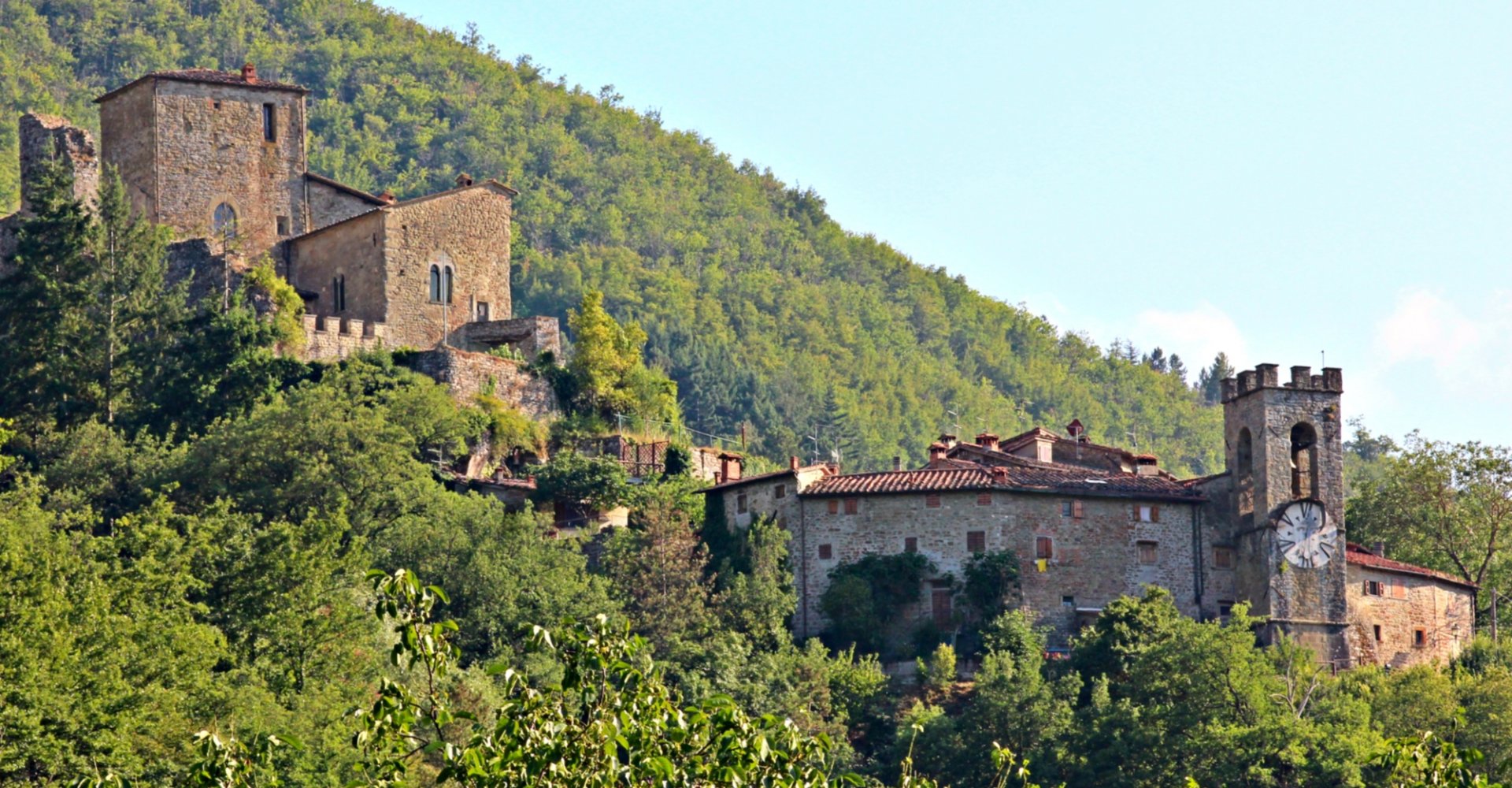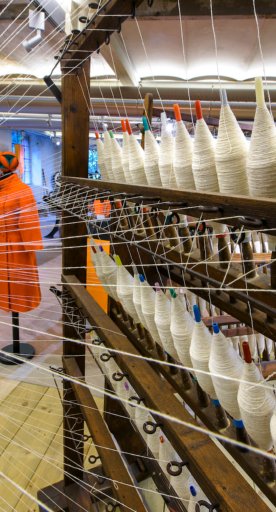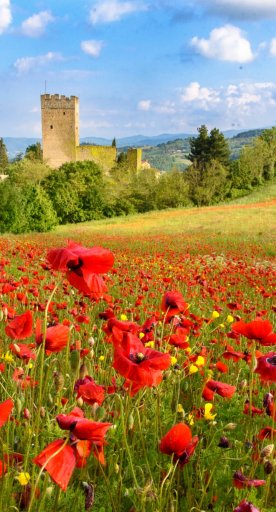Castel San Niccolò
A handful of stone hamlets on the slopes of Pratomagno
Castel San Niccolò is a scattered municipality whose main center is the village of Strada in Casentino, overlooked by that Castle of the Counts Guidi from which the name of the municipality itself derives. The castle, one of the most evocative in this part of Tuscany, was home to the Guidi Counts until 1349, when the inhabitants rose up against the power of Count Galeotto, son of Guglielmo Novello, submitting to the Florentine Republic.
From the fifteenth century it began to be part of the territories administered directly by Florence. Beginning in the eighteenth century the peoples (and various hamlets) of Vado, Garliano, San Pancrazio and Cetica Sant'Angelo joined forming what was to become the municipality of Castel San Niccolò. In 1776, following Grand Duke Leopold's Special Regulations, Borgo alla Collina was added to the four communities. Always linked to Florence and Fiesole, Castel San Niccolò was united with Arezzo in 1859. The municipality then adopted its present structure in 1868, when the ancient villages were joined by those of Caiano, Ristonchi, Battifolle and Vertelli.
What to see in Castel San Niccolò
The most important center of the community - Strada in Casentino, once also called Borgo alla Strada as opposed to Borgo alla Collina - was known because of the proximity of the Pieve di San Martino a Vado, built by the Guidi Counts in the 11th century, and which was an easy "ford" on the river Solano. The Parish church of San Martino is one of the most important Romanesque churches in Casentino and was built at the behest of Countess Matilda of Canossa.
The town center is dominated by the charming Piazza Matteotti, surrounded by the austere Vettori and Vettori-Tommasi palaces and dominated by the Logge del Grano.
In the complex of the former Salesian College is the Museo della pietra lavorata – Centro d’interpretazione Ecomuseo cdella Pietra (Museum of Handworked Stone - Interpretation Center Ecomuseum of Stone), whose purpose is to document, study, interpret and pass on the varied widespread heritage related to stone in the Solano Valley.
The most important center of the community - Strada in Casentino, once also called Borgo alla Strada as opposed to Borgo alla Collina - was known because of the proximity of the Pieve di San Martino a Vado, built by the Guidi Counts in the 11th century, and which was an easy "ford" on the river Solano. The Parish church of San Martino is one of the most important Romanesque churches in Casentino and was built at the behest of Countess Matilda of Canossa.
The town center is dominated by the charming Piazza Matteotti, surrounded by the austere Vettori and Vettori-Tommasi palaces and dominated by the Logge del Grano.
In the complex of the former Salesian College is the Museo della pietra lavorata – Centro d’interpretazione Ecomuseo cdella Pietra (Museum of Handworked Stone - Interpretation Center Ecomuseum of Stone), whose purpose is to document, study, interpret and pass on the varied widespread heritage related to stone in the Solano Valley.
In the surroundings
On the ridge of a hill that divides the Arno Valley from the Solano Valley stands Borgo alla Collina, from where the entire Casentino can be admired: castles and parish churches, mountains and forests. At a single glance, the Casentino Forests National Park, the Camaldoli Monastery, the Verna Sanctuary, the Poppi Castle, and the Castle and Parish church of Romena appear.
The so-called "hamlet" of Borgo alla Collina preserves a characteristic web of narrow streets, with houses leaning against each other, dominated by a square-towered Castle.
On the ridge of a hill that divides the Arno Valley from the Solano Valley stands Borgo alla Collina, from where the entire Casentino can be admired: castles and parish churches, mountains and forests. At a single glance, the Casentino Forests National Park, the Camaldoli Monastery, the Verna Sanctuary, the Poppi Castle, and the Castle and Parish church of Romena appear.
The so-called "hamlet" of Borgo alla Collina preserves a characteristic web of narrow streets, with houses leaning against each other, dominated by a square-towered Castle.
Events
Strada in Casentino is known as the Land of the Handworked Stone, by virtue of the ancient serena stone quarries in its territory and to the artifacts, the work of the area's many stonemasons, which have graced houses and palaces in many Tuscan cities. In the first days of September, every two years, the "Exhibition of the handworked stone" is held, in which stonemasons and sculptors from all parts of Italy participate.
The Cattle Fair (Chianina breed) in Borgo a Collina, instead, takes place every year and involves the entire valley and the entire province of Arezzo.
Strada in Casentino is known as the Land of the Handworked Stone, by virtue of the ancient serena stone quarries in its territory and to the artifacts, the work of the area's many stonemasons, which have graced houses and palaces in many Tuscan cities. In the first days of September, every two years, the "Exhibition of the handworked stone" is held, in which stonemasons and sculptors from all parts of Italy participate.
The Cattle Fair (Chianina breed) in Borgo a Collina, instead, takes place every year and involves the entire valley and the entire province of Arezzo.
Typical dishes and products
Part of the municipality of Castel San Niccolò is Cetica where, according to the first certain information, the Cetica red potato has been cultivated since the 1920s. Used in the kitchen to remedy recurring famines, from this "raw" and "poor" material comes the delicate and delicious recipe for the tortelli di patate del Casentino (Casentino potato tortelli).
Part of the municipality of Castel San Niccolò is Cetica where, according to the first certain information, the Cetica red potato has been cultivated since the 1920s. Used in the kitchen to remedy recurring famines, from this "raw" and "poor" material comes the delicate and delicious recipe for the tortelli di patate del Casentino (Casentino potato tortelli).













